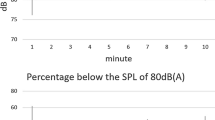Summary
The change of vocal function after vocal fold dehydration due to dryness was discussed along with the treatment effect of different atomizing agents. Forty-eight staffs from The Central Hospital of Wuhan were recruited. All volunteers breathed dry air for vocal fold dehydration. After dry air inhalation, the subjects were randomly divided into four groups, with 12 cases each. Three groups were treatment groups, receiving 0.9% normal saline (IS), 5% hypertonic saline (HS) and double-distilled water (SW) atomizing inhalation therapy, respectively, and the last group was the control group without treatment. Voice data were collected for all subjects before and immediately after dry air inhalation using the Multi-Dimensional Voice Program (MDVP) system. Atomizing inhalation therapy was given 10 min after dry air inhalation, and voice data were collected using MDVP system at the following time points after atomizing inhalation treatment: 5 min, 20 min, 35 min, 50 min, 65 min, 80 min, 95 min, 110 min. In the control group, voice data were collected at the same time points and compared with those of treatment groups. The vocal function parameters collected before and after dry air inhalation as well as after treatment were subjected to test using SPSS 16.0 software. In the four groups, jitter (fundamental frequency perturbation), shimmer (amplitude perturbation), and amplitude perturbation quotient (APQ) were significantly increased after dry air inhalation (P<0.05). In IS, HS and SW groups, after atomizing inhalation treatment, there was an obvious reduction in jitter, shimmer and APQ, showing significant differences as compared with those after dry air inhalation (P<0.05). Moreover, these parameters were significantly lower than those in the control group (P<0.05). The jitter, shimmer and APQ in the IS group were significantly lower than those in the HS and SW groups (P<0.05). We are led to a conclusion: Vocal fold dehydration induced by dryness can reduce the stability of voice; such decreased voice stability can be improved by atomizing inhalation therapy; without proper treatment, voice stability caused by vocal fold dehydration cannot heal spontaneously; of three atomizing agents namely, IS, HS and SW, IS had the best treatment effect for decreased voice stability caused by vocal fold dehydration.
Similar content being viewed by others
References
Li W, Qu JN, Yang XN, et al. The Influence of Vocal Fold Dehydration on Voice Acoustic Function and the Effect of Hydration Inhalation Treatment. Tinglixue Yu Yanyu Jibing Zazhi (Chinese), 2013,21(3):252–254
Titze IR. Principles of Voice Production. Prentice Hall, Englewood Cliffs, NJ, 1994.
Ye Q, Yang YM, Sun AH, et al. Sensibility of different vowels in voice assessment. Tinglixue Yu Yanyu Jibing Zazhi (Chinese), 2002,10(2):82–83
Roh JL, Kim HS. The Effect of Acute Xerostomia on Vocal Function. Arch Otolaryngol Head Neck Surg, 2006,5(5):542–546
Sataloff RT, Hawkshaw M, Rosen D. Medications: effects and side effects in professional voice users. In: Sataloff, editor. Professional Voice: The Science and Art of Clinical Care. San Diego, 1997.
Fisher KV, Telser A, Phillips JE, et al. Regulation of vocal fold transepithelial water fluxes. J Appl Physiol, 2001,91(3):1401–1411
Tao C, Jiang J, Zhang Y. A fluid-saturated poroelastic model of the vocal folds with hydrated tissue. J Biomech, 2009,42(6):774–780
Bless DM. Assessment of laryngeal function. In: Ford CN, Bless DM, eds. Phonosurgery. New York, NY: Raven Press, 1991.
Verdolini K, Min Y, Titze IR, et al. Biological mechanisms underlying voice changes due to dehydration. J Speech Lang Hear Res, 2002,45(2):268–282
Fisher KV, Ligon J, Sobecks JL, et al. Phonatory effects of body fluid removal. J Speech Lang Hear Res, 2001,44(2):354–367
Solomon NP, DiMattia MS. Effects of a vocally fatiguing task and systemic hydration on phonation threshold pressure. J Voice, 2000,14(3):341–362
Sivasankar M, Fisher KV. Oral breathing increases PTP and vocal effort by superficial drying of vocal fold mucosa. J Voice, 2002,16(2):172–181
Sivasankar M, Fisher KV. Oral breathing challenges in participants with vocal attrition. J Speech Hear Res, 2003,46(6):1416–1427
Vintturi J, Alku P, Sala E, et al. Loading-related subjective symptoms during a vocal loading test with special reference to gender and some ergonomic factors. Folia Phoniatr Logop, 2003,55(2):55–69
Hemler RJ, Wienke GH, Dejonckere PH. The effect of relative humidity of inhaled air on acoustic parameters of voice in normal subjects. J Voice, 1997,11(3):295–300
Tanner K, Roy N, Merrill R, et al. The effects of three nebulized osmotic agents in the dry larynx. J Speech Hear Res, 2007,50(3):635–646
Jiang JJ, Ng J, Hanson D. The effects of rehydration on phonation in excised canine larynges. J Voice, 1999,13(1):51–59
Yiu E, Chan R. Effects of hydration and vocal rest on vocal fatigue in amateur singers. J Voice, 2003,17(2):216–227
Titze IR. The physics of small-amplitude oscillation of the vocal folds. J Acoust Soc Am, 1988,83(4):1536–1552
Wei C, Zhang Y, Au WW. Simulation of ultrasound beam formation of baiji (Lipotes vexillifer) with a finite element model. J Acoust Soc Am, 2014,136(1):423–429
Leydon C, Fisher KV, Lodewyck-Falciglia D. The cystic fibrosis transmembrane conductance regulator and chloride-dependent ion fluxes of ovine vocal fold epithelium. J Speech Lang Hear Res, 2009,52(3):745–754
Hille B. Ion Channels of Excitable Membranes. Sunderland, MA: Sinauer, 2001.
Author information
Authors and Affiliations
Corresponding author
Additional information
Conflict of Interest Statement
The authors had no conflicts of interest to declare in relation to this article.
Rights and permissions
About this article
Cite this article
Zou, Zf., Chen, W., Li, W. et al. Impact of Vocal Fold Dehydration on Vocal Function and Its Treatment. CURR MED SCI 39, 310–316 (2019). https://doi.org/10.1007/s11596-019-2036-0
Received:
Revised:
Published:
Issue Date:
DOI: https://doi.org/10.1007/s11596-019-2036-0




